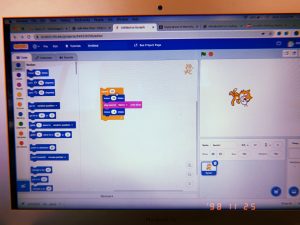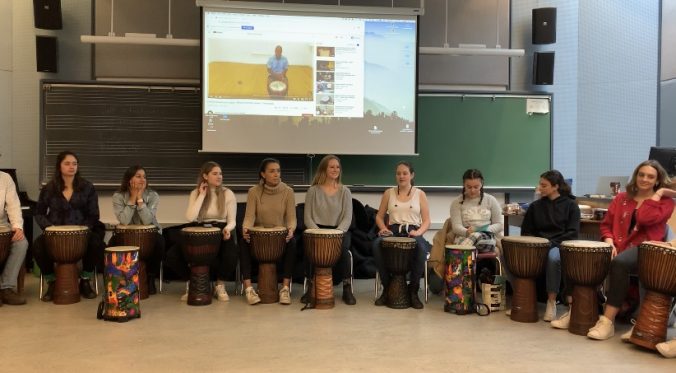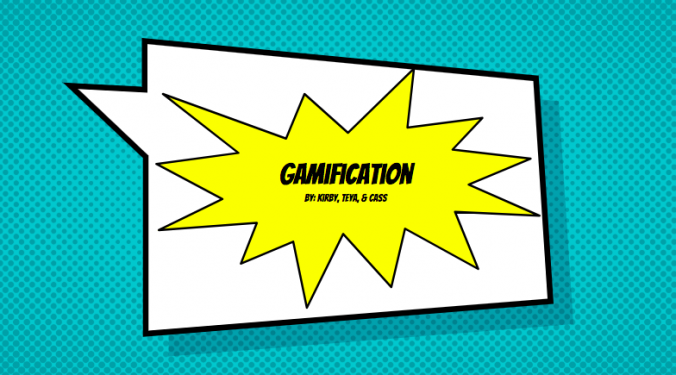In our story drama unit there were many story dramas that spoke to me as being wonderful mentor texts and great storybooks to read as a class to find the meaning or message the book was wanting to convey; however, there was only one book that made me think more of just how good of a read the book was, in fact, it made me reconsider how valuable drama can be. Our storybook drama on “Magic Beads” begun with a workshop from Phil where we talked mostly about miming techniques and improvisation and not much about the actual book. However, this workshop was still quite wonderful! I remember distinctly an improvised scene that Jess, Teya and I did where we were exampling what we would take to a show and tell day at class. I remember the response we received from the instructors and the class as our improvised scene humouring and quite enjoyable to watch. I found it interesting that after experiencing such a light-hearted workshop that the story is related to was quite different in theme. In the next class, we got to read the story with no story drama pausing which was a change from what we were used to experiencing. The story explains two different plots; one about how a little girl is new to her school and nervous for show and tell and how she doesn’t have anything to share, and the other about her and her mom living in a shelter house because they have fled an abusive father/husband. Reading Magic Beads to one of my future classes at first made me very uncomfortable, how am I as a teacher who has experienced nothing even close to the realness of this story am supposed to tell this story to potential children dealing with lives similar. In my head, I thought that since this is such an emotional topic and since I have no relevant knowledge of any sort that the topic of abusive, poverty and so fourth should be just covered up and not discussed. Conversely, “[I] know that [teachers] have enormous power to influence the future of the students in our care. We need to be mindful of that power and to remain consistently conscious of what it means to teach fairly in an unfair world” (Lundy & Swartz, 2011, p. 5) and it is because of this that the realization of having an open discussion on topics like this came to me. It is the role of teachers to have uncomfortable discussions that students need to hear for them to feel comfortable about asking us for help. By opening the discussion up in a harmless way of a storybook we (as teachers) are inviting students to relate and feel safe discussing their situations. This workshop and the reading of Magic Beads helped me also recognize the importance of mentor texts and how they can support students in their learning and lives.
Author: kirbyjarvis (Page 5 of 9)
One of the most memorable moments in this course for myself was the class where we had a professional mime come in and teach us all about the basics of miming and even some improvisation scenes. I remember that class distinctly because we were all very excited to be participating in a drama workshop with Phil and the professional mime because we had been told how marvelous they were. When the workshop begun the feelings of our class at that moment remind me of a quote that I read in one of my readings; “tension is the secret, the mystery, the surprise, the dangling carrot, the time frame, and the space limit,” (Booth, 2005, p. 40) we as a class were not used to other teachers in our class and different pedagogical techniques and you could tell we were antsy with anticipation. The workshop continued and I could feel that the tension we held at the beginning was turning into energy that was bouncing off each other. We learned about the artistry and history of miming as well with of course the dramatic aspects of mime. A concept we learned was how mime is the theatrical display of movement, space, and time; this was interesting to me because I always just assumed mime was simply acting without speaking. I think the most memorable part of this class if you put aside learning how to run, walk, and so fourth was the feelings of collectiveness that were brought into the classroom. The professional mime had a knack at making every student in the class feel supported and feel like they were succeeding greatly, and it was when these people were shouted out by him when our class came together and congratulated one another. It was obvious in the moments when each of us would perform the movement solo and everyone would cheer and clap that you could tell we were a group that is genuinely supportive of one another. As all future teacher “we all long for the perfect class, the one where everyone gets along and where there is joy in learning about the curriculum…” (Lundy & Swartz, 2011, p. 5) and from the miming experience, I can say with confidence that we all wished that one day we could have a class that had the same emotional and physical connection as our class has.
In our music lesson teaching our class about the basics of the West African drum the djembe we brought the first peoples’ principle (FPPL) Learning is embedded in memory, history, and story into the classroom. We used this principle because of the goal of our class is a social studies lesson as well as a musical one. Throughout the entirety of the intro to the lesson, we gave the children an in-depth historical lecture about the origins of the drum and what the drum was meant for back when it was first brought into West African culture. We also talked about how each drum was unique to the owner as the wooden portion of the drum represents its connection to the family. The wood would be telling the family tree story of the owner connecting the youth (fruit and leaves) and the ancestors (the roots underground). From this incorporation of the FPPL our goal was to not only introduce some new and interesting information to our class but to also show them how important it is to remember that musical instruments are so different all around the world and that it is important that before we chose to want to experiment and play with them, we must respect the historical content of the instruments.
The process of creating this music plan was pretty seamless. We begun by choosing the subject we wished to interrogate into our lesson which Sam and I just picked the social sciences more specifically social studies, we chose this subject because we didn’t want to double up on any subjects. From there it was Maddy who thought of the great idea of drumming and found the video that would be the base of our assignment. We split the work up by looking at all the music lesson plan sections and splitting them off according to how much work each required. I got to make up the physical lesson plan and teaching cues; which I was more than happy to do because it makes me comfortable knowing exactly what is going on. The actual lesson I thought was quite successful, again we all just split up the parts of the lesson and made sure everyone would get a chance to talk and we decided that if anyone had any extra opportunities or felt that someone else needed assistance in their portion we would just chip in with comments. It was my job to teach the warm-up lesson, which went smooth after watching the video, I felt that I had a great voice and teaching cues which the class all listened to me, the class was also engaged and non-disruptive throughout all my teaching. I hope that the class enjoyed the lesson as much as it seemed like in person and I hope they all felt that they got to not only have fun but also learn something they didn’t know before.
Today we officially finished our tech class by presenting our tech inquiry project! The project was displayed as a google slides project and turned out to be pretty fantastic. Teya, Cass and I decorated our presentation by adding our little bitmojis to each slide to match the “gaming” theme of our presentation. The presentation went well and we got great audience feedback on both our presenting skills and our slide show. It is sad to think that I might not make another blog specifically towards my education at UVIC however, there is 100% a part of me that knows I will continue blogging my life in its everyday ways as it is a reminder to me about how each day has its successes and sometimes you just gotta sit down and write a blog to remember and appreciate each one.
“Technology will never replace great teachers but
technology in the hands of great teachers is transformational”
Today I got a very interesting experience of being in virtual reality, now before I get ahead of myself I should probably mention that I have experienced virtual reality before, my first experience however was A LOT different than this one. My first experience of virtual reality was on a playstation 4 and was involving lots and lots of scary zombies, as you can tell from my reaction to the experience it was one of the scariest things I have yet to experience.
Thank the gods that the next virtual reality was a much more calming (if you call calming roller coasters) experience.
What a wonderful way to end our final tech class for the year! And it was pretty crazy learning all about the ways that VR can be adapted into a classroom and especially learning which type of learners it helps the most and how it can be so cross-cultural.
Disadvantages when it comes to implementing gamification in the classroom can be varies depending on schools, policies, and beliefs. The main disadvantages I found in my research that could be spread the easiest across all sectors were:
- Decreases student’s attention span researchers are finding that the fast pace and immediate reward system of gamification create issues in students’ attention spans. This issue could rebound on to the student’s other learning and they may feel disappointed in the other parts of their education when they find out that they cannot have the same kind of feedback learning experience.
- Cost is an issue that can occur when it comes to using gamification systems in large schools, and for many students. There may be equipment costs, software costs, and training costs for instructors that sometimes get passed off to student registration fees. There are often also maintenance-related costs for systems delivered or hosted in schools
- Student assessment can get difficult when it comes to telling how the results of these gamification results tie into the curriculum and into the overall assessment of the students learning. Most games do have a built-in tracking system but you will need to find a way to translate the games results to fulfill curricular competencies.
- Game logistic Many times, setting up a game for your course requires a lot of prior planning and logistics. Questions you need to ask are: Will students be able to play the game at home? Is there an additional cost if they use it outside of the classroom? Are there are enough computers available for students to play the game in class? Most of the time you will need to sit down and play the game yourself all the way through, which can take about 40 hours before you fully understand the game and objectives.
Today Rich McCue came in to give us a beginning lesson for how to integrate and teach coding in our classrooms. He began the lesson by asking us why we think we should teach coding in elementary classrooms, some answers the class came up with was we teach coding to spark interest in this area as a potential career opportunity and that since coding and gaming is so popular for children they will be willing to learn more and be engaged in the material. We had the opportunity to visit a few of the coding sites Rich had found beneficial for elementary classrooms, the programs found were Scratch, Grasshopper, Hour of Code, Designing with algorithms using Tinkercad, and Code BC. Since my experience in coding is virtually nonexistent since my grade 7 robotics day it was sedimental going back and trying to figure out what little 13-year-old me back in the day. Since Scratch was said to be the simplest formatting for coding I decided to attempt it and use the “Scratch-Getting-Started-Guide-Basic” PDF that Rich provided us. My little scratch cat ended up only being able to move in a circle and saying “Aye there mate” however once I threw in a dinosaur friend my cat seemed to be a lot happier.

I also attempted how to code using the Grasshopper gaming system, this game was more realistic for a student because it showed code using a real coding looking formula. Below is a video of me successfully producing a flag.
It is now the eve before I have to hand in my final musical growth video for music and I am not going to lie I am nervous. It took me over 2 weeks to memorize how to play the beginning picking of Fast Car and I am still not happy with my pace or with my transitions from chord to chord. I realized that I took far too much time and effort working on the beginning intro part of the song and now my usual easy strumming abilities are being compromised throughout the rest of the song. The resources that are assisting me throughout this process have been “play with me” youtube tutorials and writing down cheat notes for strumming patterns and for my picking patters. As noted in my last blogs I wanted to attempt to understand how the picking pattern diagrams work, however, after many attempts of googling and referring back and forth from my ukulele to the online pattern diagrams, I realized that is for my best interest that I should just memorize how the YouTuber plays and then just forget about learning to read these diagrams for the time being. It is not all bad news though, although my picking and my strumming are not to my expectations my singing hasn’t failed me. Fast Car is my all-time favorite song and it is my goal to be dancing my first dance at my wedding to this very song (preferably with Tracy Champman live singing) so the lyrics come easy to me and I find myself naturally singing alone to my playing. Because Fast Car is one of my most favorite songs I think that this is part of the reason why I am feeling so discouraged about my process of learning to play this song. I wish to play this song to the best of my abilities and do give this song the justice it deserves.
Even though this is my final blog required for EDCI 306 this does not mean that I am stopping my ukulele playing or giving up on Fast Car. It is important to me that I can bring music into my future classroom as a teacher and I can just imagine how cute it would be learning new songs for my students every week as we sit for carpet time. We will see how tomorrow goes for filming and hopefully I will feel more confident by the time of my last practice session tonight.
 As the time comes for me to start my first practicum, the time comes also for me to start really thinking about who I am and what persona, pedagogies, and teachings I want to bring in with me into the classroom. I realize that in my practicum I will get the opportunity to be able to observe and work with professionals and I can further my knowledge as an educator by experiencing new teaching pedagogies first hand. However, I still feel that I wish to find out more about myself as a person and as a teacher so I can bring these aspects into my class with confidence knowing what I am teaching is truly my style. I hope that no matter what my first practicum experience will allow me to grow as an educator and that my passion for education and educating children will be well received and beneficial for both my students and myself.
As the time comes for me to start my first practicum, the time comes also for me to start really thinking about who I am and what persona, pedagogies, and teachings I want to bring in with me into the classroom. I realize that in my practicum I will get the opportunity to be able to observe and work with professionals and I can further my knowledge as an educator by experiencing new teaching pedagogies first hand. However, I still feel that I wish to find out more about myself as a person and as a teacher so I can bring these aspects into my class with confidence knowing what I am teaching is truly my style. I hope that no matter what my first practicum experience will allow me to grow as an educator and that my passion for education and educating children will be well received and beneficial for both my students and myself.





Recent Comments